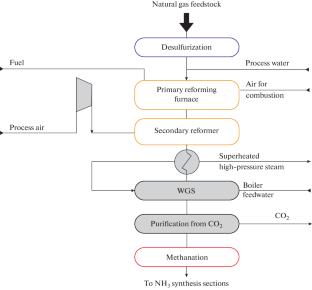天然气制合成气催化剂与技术的现代水平
IF 0.7
Q4 ENGINEERING, CHEMICAL
引用次数: 0
摘要
分析了天然气制合成气进一步转化为氨、甲醇和氢气的主要催化剂和工业技术水平。介绍了甲烷重整和CO蒸汽重整不同阶段的工艺流程、催化剂和吸附剂的发展趋势,以降低能源和资源的消耗。本文章由计算机程序翻译,如有差异,请以英文原文为准。

Modern Level of Catalysts and Technologies for the Conversion of Natural Gas into Syngas
The level of the main catalysts and industrial technologies for the conversion of natural gas into syngas further convrted into ammonia, methanol, and H2 was analyzed. The main trends in their development, aimed at reducing the energy and resources consumption, were described including process flowsheets, catalysts, and sorbents at different stages of methane reforming and CO steam reforming.
求助全文
通过发布文献求助,成功后即可免费获取论文全文。
去求助
来源期刊

Catalysis in Industry
ENGINEERING, CHEMICAL-
CiteScore
1.30
自引率
14.30%
发文量
21
期刊介绍:
The journal covers the following topical areas:
Analysis of specific industrial catalytic processes: Production and use of catalysts in branches of industry: chemical, petrochemical, oil-refining, pharmaceutical, organic synthesis, fuel-energetic industries, environment protection, biocatalysis; technology of industrial catalytic processes (generalization of practical experience, improvements, and modernization); technology of catalysts production, raw materials and equipment; control of catalysts quality; starting, reduction, passivation, discharge, storage of catalysts; catalytic reactors.Theoretical foundations of industrial catalysis and technologies: Research, studies, and concepts : search for and development of new catalysts and new types of supports, formation of active components, and mechanochemistry in catalysis; comprehensive studies of work-out catalysts and analysis of deactivation mechanisms; studies of the catalytic process at different scale levels (laboratory, pilot plant, industrial); kinetics of industrial and newly developed catalytic processes and development of kinetic models; nonlinear dynamics and nonlinear phenomena in catalysis: multiplicity of stationary states, stepwise changes in regimes, etc. Advances in catalysis: Catalysis and gas chemistry; catalysis and new energy technologies; biocatalysis; nanocatalysis; catalysis and new construction materials.History of the development of industrial catalysis.
 求助内容:
求助内容: 应助结果提醒方式:
应助结果提醒方式:


